The Officers' Training Corps (OTC), more fully called the University Officers' Training Corps (UOTC), are military leadership training units operated by the British Army. Their focus is to develop the leadership abilities of their members whilst giving them an opportunity to take part in military life whilst at university. OTCs also organise non-military outdoor pursuits such as hill walking and mountaineering. UOTC units are not deployable units nor are their cadets classed as trained soldiers until completion of MOD 1 training. The majority of members of the UOTC do not go on to serve in the regular or reserve forces.

The Post Office Rifles was a unit of the British Army formed in 1868 from volunteers as part of the Volunteer Force, which later became the Territorial Force. The unit evolved several times until 1935, after which the name was lost during one of many reorganisations.
The Robin Hood Battalion was a unit of the Volunteer Force of the British Army and Territorial Force, later the Territorial Army. The battalion served as infantry during the 1916 Easter Uprising in Dublin and then served on the Western Front during World War I. In the 1930s it re-roled as an anti-aircraft unit and served in World War II, including North-western Europe from June 1944 to May 1945.

The 51st Highland Volunteers is a battalion in the British Army's Army Reserve or reserve force in the Scottish Highlands, forming the 7th Battalion of the Royal Regiment of Scotland, also known as 7 SCOTS. It is one of two Reserve battalions in the Royal Regiment of Scotland, along with 52nd Lowland, a similar unit located in the Scottish Lowlands.
Enoggera Barracks is an Australian Army base in the northwestern Brisbane suburb of Enoggera in Queensland, Australia. It was officially established in the early 20th century when the area was used for field training, although the area was used by military units as far back as the mid-19th century. Since then it has been developed into a modern military base, which is now home to units of the 7th and 11th Brigades as well as the headquarters of the 1st Division and the 16th Aviation Brigade.

The Volunteer Force was a citizen army of part-time rifle, artillery and engineer corps, created as a popular movement throughout the British Empire in 1859. Originally highly autonomous, the units of volunteers became increasingly integrated with the British Army after the Childers Reforms in 1881, before forming part of the Territorial Force in 1908. Most of the regiments of the present Army Reserves Infantry, Artillery, Engineers and Signals units are directly descended from Volunteer Force units.
308th Infantry Brigade was a formation of the British Army organised from surplus Royal Artillery (RA) personnel retrained as infantry towards the end of the Second World War.
The Paddington Rifles was a unit of the Territorial Army.
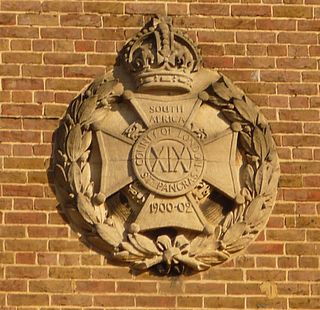
The 19th Battalion, London Regiment was a Volunteer unit of the British Army in existence from 1860 to 1961 under various titles. A detachment served in the Second Boer War and two full battalions fought in World War I, receiving the surrender of Jerusalem and crossing the Jordan among other exploits. During World War II the regiment operated as a searchlight unit and briefly as an infantry battalion, before becoming an anti-aircraft regiment in the postwar years.

Fulham House is a former military installation at 87 Fulham High Street, Fulham, London. It is a Grade II listed building.
The 20th Battalion, The London Regiment , was a unit of Britain's Territorial Force formed in 1908 from Volunteer corps dating back to 1859. It saw considerable service on the Western Front, at Salonika and in Palestine during the First World War. It served as a searchlight regiment and later as an infantry regiment during the Second World War.

The 71st Searchlight Regiment, Royal Artillery was an air defence unit of Britain's Territorial Army (TA), which was raised just before the outbreak of World War II and served as part of Anti-Aircraft Command during and after the war.
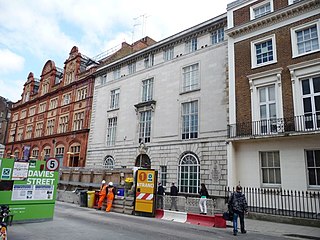
The Davies Street drill hall is a former military installation in Davies Street, London.

The Iverna Gardens drill hall is a military installation in Kensington, London.

The Buckingham Gate drill halls were military installations at 58 and 59 Buckingham Gate, London.
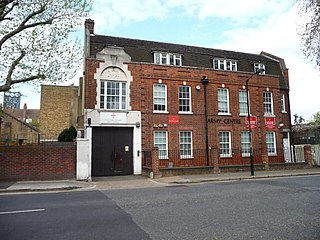
The Braganza Street drill hall is a military installation in Braganza Street, Walworth.
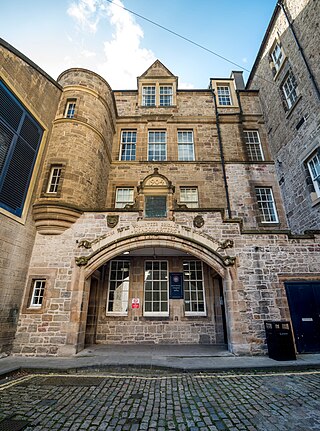
The Forrest Hill drill hall is a former military installation in Edinburgh, Scotland. The building is now owned by the University of Edinburgh.

Mitcham Road Barracks is an Army Reserve centre in Croydon, London, with a history dating back to 1794.
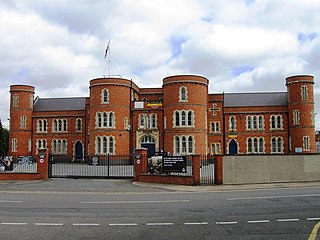
The Clare Street drill hall is a military installation in Northampton, Northamptonshire. It is a Grade II listed building.
The 4th Battalion, Queen's Royal Regiment was a volunteer unit of the British Army from 1859 to 1961. Beginning from small independent units recruited in the South London suburbs, it was attached to the Queen's Royal Regiment and served in the Second Boer War, the First World War, and the Third Anglo-Afghan War. Before the Second World War, it was converted into a Royal Artillery searchlight regiment that served in the Battle of Britain and The Blitz. Later it became a light anti-aircraft gun unit serving on blockships in the Mulberry harbour during the Normandy invasion, and then defended the port of Antwerp in the closing stages of the war. Postwar it continued in the air defence role before rejoining the Queen's Regiment as infantry.














